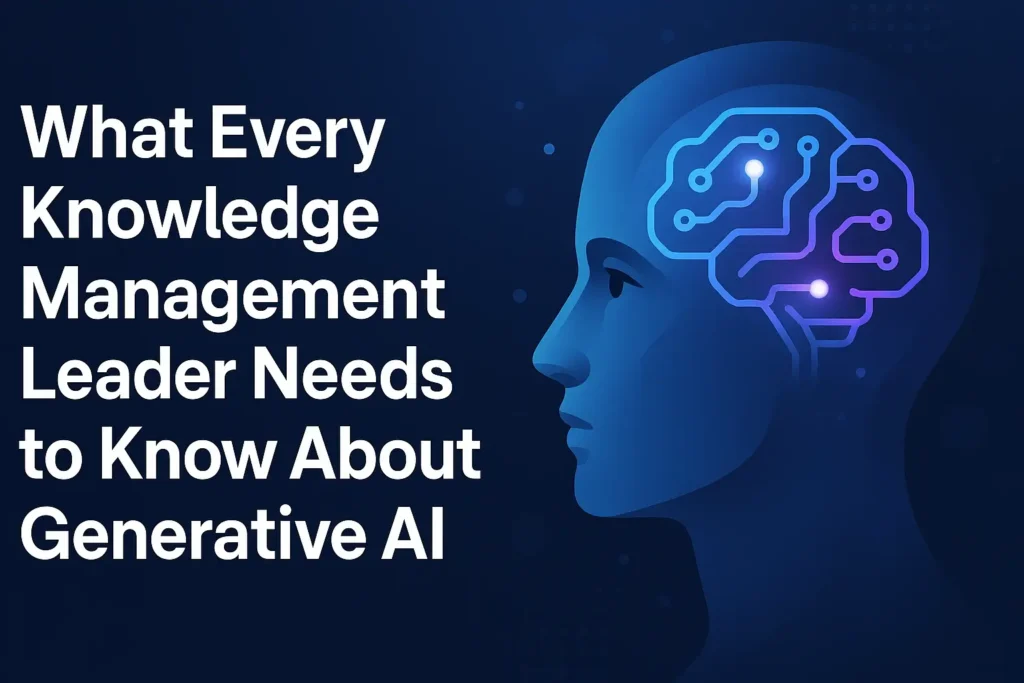Generative AI is showing up everywhere—from content creation and search to chatbots and internal decision-making tools. But here’s the thing: all that impressive output? It depends on the quality and structure of your organization’s knowledge.
If you’re leading Knowledge Management, you can’t afford to treat generative AI as “just another IT trend.” This shift directly affects how knowledge is captured, shared, retrieved, and trusted.
In this article, we’ll break down what generative AI really means for KM, what risks it introduces, and how Knowledge Management leaders can take the lead—not play catch-up.

Knowledge Management
1. Generative AI Isn’t Magic—It’s Prediction Based on Patterns
Let’s start by cutting through the hype.
Generative AI doesn’t “think.” It doesn’t “understand.” It predicts. It analyzes patterns from massive amounts of data and generates new content that statistically fits the input it receives.
What does that mean for Knowledge Management? It means the AI only knows what it’s seen. If your internal knowledge is incomplete, outdated, or disorganized, the AI will mirror those flaws—and your people will trust the wrong answers.
That’s why Knowledge Management is essential: it ensures the information that trains, feeds, or supports AI is high quality.
2. Generative AI Will Change How People Search and Learn
People are already turning to AI tools like ChatGPT, Microsoft Copilot, and others instead of clicking through folders or manuals. This changes the game for Knowledge Management.
Here’s how:
- Employees expect instant, conversational answers—not long documents
- Search is no longer keyword-based; it’s semantic and contextual
- Static content is less useful than content with embedded metadata, structure, and narrative logic
Knowledge Management teams need to shift from managing documents to managing knowledge assets built for generative workflows.
3. The Risk: Confidently Wrong Answers
One of the biggest risks with generative AI is that it sounds confident—even when it’s wrong. If AI tools pull from the wrong version of a policy or from outdated procedures, they may provide responses that seem credible but are totally inaccurate.
This is where structured, verified, well-maintained knowledge makes the difference.
To reduce this risk:
- Maintain a clear knowledge validation workflow
- Set up knowledge governance roles and rules
- Train your AI using trusted internal sources—not just public data
4. Generative AI Is Only as Smart as the Knowledge You Provide
Let’s take an internal chatbot example. If a sales rep asks, “How do I handle a refund request?” and your knowledge base hasn’t been updated in a year, the AI will either hallucinate—or surface something irrelevant.
Here’s what helps:
- Make sure core knowledge is reviewed and tagged regularly
- Use AI training loops to identify gaps (e.g., what questions go unanswered)
- Align your Knowledge Management team with IT and data teams to improve model inputs
AI’s value isn’t in replacing your team. It’s in amplifying your team’s access to good knowledge. But that only works if KM owns the quality pipeline.
5. The Opportunity: Scalable Knowledge Capture
This is where Knowledge Management leaders can shine.
Generative AI tools can help capture knowledge faster:
- Record and summarize expert interviews
- Turn meeting transcripts into structured insights
- Draft help articles or guides based on Slack conversations or tickets
Your job isn’t to let AI publish freely. It’s to let AI assist your people in capturing and organizing their knowledge, faster and with less friction.
6. Governance: Who Owns the Content Behind the Bot?
Knowledge Management leaders need to ask tough questions:
- Where is our AI pulling knowledge from?
- Who’s reviewing that knowledge?
- What happens when something goes wrong?
Make sure you set up:
- Clear approval workflows for AI training data
- Content owners for major knowledge areas
- Review cycles for any surfaced or reused content
7. Metrics Will Shift from Access to Accuracy
Traditional Knowledge Management success metrics often focus on usage—how many people viewed an article, or how often a knowledge base was accessed.
In the AI era, accuracy and relevance are more important. You’ll need to measure:
- How often AI gives correct answers (vs. escalations or corrections)
- Which articles are being pulled most by AI—and how well they perform
- Where users are reporting confusion or gaps
This kind of data can make KM a performance driver, not just a repository manager.
8. Your Role: From Knowledge Curator to Knowledge Strategist
In a generative AI world, KM leaders move beyond content librarianship.
You become the strategic lead who:
- Aligns AI capabilities with real knowledge needs
- Translates expert insight into reusable content
- Builds trust by ensuring knowledge flows safely into AI
The job is bigger, yes—but also more impactful than ever.
Final Thoughts
Generative AI is here, and it’s changing how people create, find, and use knowledge.
That’s not a threat to KM—it’s an invitation. An invitation to lead, to shape the systems behind AI, and to make sure that when your people turn to a machine for help, the answer they get is trustworthy.
Because if AI is the engine, KM is the fuel.
And it’s your job to make sure it’s clean, high-quality, and always ready to go.
Frequently Asked Questions
Subscribe to receive notifications for free webinars on Knowledge Management.
